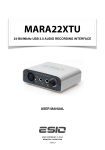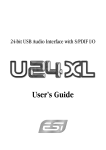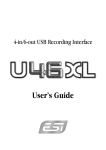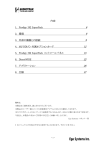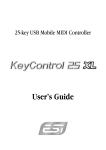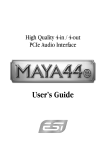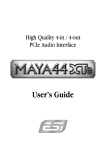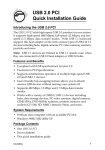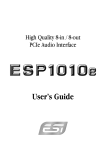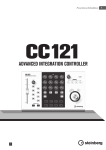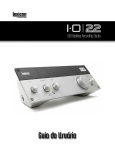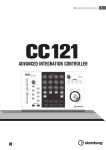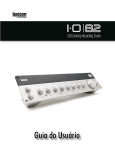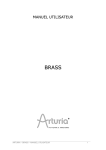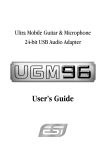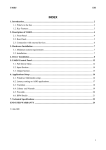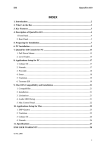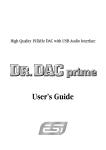Download ESI GIGAPort HD
Transcript
8 output USB Audio Interface User’s Guide ESI - Copyright © 2008 Revision 1, July 2008 www.esi-audio.com ESI GIGAPORT HD INDEX 1. Introduction.................................................................................................................................. 4 1.1 Features................................................................................................................................................................ 4 2. Installation .................................................................................................................................... 5 2.1 System Recommendation..................................................................................................................................... 5 2.2 Hardware Installation........................................................................................................................................... 5 2.3 Driver Installation ................................................................................................................................................ 5 3. Control Panel................................................................................................................................ 9 4. Setting in Applications............................................................................................................... 10 4.1 Windows Multimedia setup ............................................................................................................................... 10 4.2 Cubase LE 4....................................................................................................................................................... 10 5. Specifications .............................................................................................................................. 12 6. General Information .................................................................................................................. 13 3 ESI GIGAPORT HD 1. Introduction Congratulations on your purchase of the ESI GIGAPORT HD. GIGAPORT HD is a USB audio interface, that provides 8 analog output channels and two independent high quality stereo headphone outputs. It is very easy to use, small and powerful. With our excellent driver support GIGAPORT HD works perfect with all current recording and sequencer applications. The USB connection makes installation extremly simple. Just plug it in and it works! 1.1 Features GIGAPORT HD is connected to the computer with a fixed USB connection cable. In addition the product has these features: 1. 8 analog outputs 2. headphone output for mixed channel playback 3. headphone output for channel 1/2 playback The cool compact design allows you to take GIGAPORT HD with you, wherever you go. As companion to a notebook computer, you can take your projects with you. GIGAPORT HD is simple to install and even easier to use. Working with samples, as a DJ or with software synthesizers has never been easier, with the help from GIGAPORT HD. The hardware works perfectly with important ASIO compatible software applications such as Cubase, Reaktor, Reason or Live and many others. 4 ESI GIGAPORT HD 2. Installation 2.1 System Recommendation GIGAPORT HD is not simply a standard digital audio interface card, but a high-resolution device capable of advanced processing of audio content. Even though GIGAPORT HD is built to have low-CPU resource dependability, system specifications play a key part in the GIGAPORT HDs performance. Systems with more advanced components are generally recommended. Minimum System Requirements PC - Intel Pentium II 300MHz CPU or comparable AMD CPU (or equivalent) – we recommend at least a Pentium III CPU with 600 MHz - Windows XP or Windows Vista operating system - 1 available USB port - at least 64MB RAM - high quality audio software with ASIO support recommended Mac - Power Macintosh G3 or higher - 1 available USB port - at least 64MB RAM - Mac OS X 10.4 or higher 2.2 Hardware Installation GIGAPORT HD is simply connected to an available USB port of your computer. A separate power supply is not required, as GIGAPORT HD is a USB powered device. Simply install the hardware by plugging it into your computer. USB port of a computer 2.3 Driver Installation After the connection of GIGAPORT HD, the operating system automatically detects it as a new hardware device. Modern operating systems like Windows XP, Windows Vista or Mac OS X usually detect the hardware directly and are installing the correct USB audio drivers automatically. You can use GIGAPORT HD already now in typical consumer audio applications that do not need special professional ASIO driver support. Under Windows XP this could be for example programs 5 ESI GIGAPORT HD used for DVD playback or more simple DJ applications that don’t require ASIO. Under Mac OS X this could be applications like Garageband. Please note that our special driver is also required if you are using higher sample rates than 44.1kHz. Installation under Windows XP Unplug the device before you start the installer if it is already connected. Then launch setup.exe from the Windows folder of the included driver CD or from a download of a recent driver from our website. You will now see a dialog as shown on the left picture below. Click Next. You can define the target directory for the installation now. Confirm it with Next. The installer now informs you that the driver installation will start as shown on the left picture below. Confirm this with Next. During the following process you will see a dialog box once or several times that informs you that the driver software has not passed Windows Logo testing. Please be assured that our drivers have been tested in various different ways and are OK to be used. Confirm any such dialog with Continue Anyway. You will now be prompted to connect the hardware on the next dialog that is shown below on the left. Plug in GIGAPORT HD. Do not click Next yet. During the driver installation, Windows might 6 ESI GIGAPORT HD again prompt you to confirm the Windows Logo testing dialog once or several times with Continue Anway before the driver installation is finalized. You can now finally click Next on the ESI GIGAPORT HD Audio Driver Setup dialog. The installation is now finished. To confirm this, please check if the ESI icon is displayed in the taskbar notification area as shown below. Sometimes a reboot is required. If yes, the driver installation has been completed successfully. Installation under Windows Vista Unplug the device before you start the installer if it is already connected. Then launch setup.exe from the Windows folder of the included driver CD or from a download of a recent driver from our website. When launching the installation, Windows Vista might prompt a security message. Make sure to allow the installation. You will then see a dialog as shown on the left picture below. Click Next. You can define the target directory for the installation now. Confirm it with Next. 7 ESI GIGAPORT HD The installer now informs you that the driver installation will start as shown on the left picture below. Confirm this with Next. During the following process you might see a Windows Security dialog box once or several times that asks you for confirmation to install the driver software. Confirm any such dialog with Install. You will now be prompted to connect the hardware on the next dialog that is shown below on the left. Plug in GIGAPORT HD. Do not click Next yet. Instead, wait a few seconds for the automatic device driver installation. You can monitor this in the task notification area where Windows Vista informs that the driver is installed via a bubble message box. You can now finally click Next on the ESI GIGAPORT HD Audio Driver Setup dialog. The installation is now finished. To confirm this, please check if the ESI icon is displayed in the taskbar notification area as shown below. Sometimes a reboot is required. If yes, the driver installation has been completed successfully. 8 ESI GIGAPORT HD 3. Control Panel This chapter describes the GIGAPORT HD Control Panel under Windows. Under Mac OS X no special Control Panel is required. To open the control panel double click on the ESI icon in the task notification area. The following dialog will appear: The Output section controls the playback volume of each playback signal from your audio applications. There are eight individual faders for each playback channel, divided into the 1/2, 3/4, 5/6 and 7/8 sections. The M button under each channel pair allows you to mute playback for that specific channel pair. A colored M button indicates that the mute function is enabled. When disabled, the button is gray. The Master section allows you to control the playback volume of the main master signal. SampleRate mode selection Under Config > SampleRate, you can select the playback mode and sample rate. By default, playback with up to 8 channels and 44.1kHz is selected (at up to 16-bit playback resolution). You can change this to 6 channels at max 24-bit resolution with either 44.1 or 48 kHz and you can select 96kHz playback at 24-bit with maximum 2 simultaneous channels. Please note that you must change these settings before launching any audio application accessing GIGAPORT HD. You cannot change these settings while any software accesses the hardware, so you need to set up your requirements before you launch your software. 9 ESI GIGAPORT HD Latency setting With the Latency menu entry under Config, you can change the latency of the driver of GIGAPORT HD. Depending on the typical application (e.g. for playback of software synthesizers) a smaller latency is an advantage. At the same time, the best latency setting indirectly depends on the performance of your system. For most default applications, a typical latency buffer size between 128 and 256 is standard. On a slow system, 512 is an option. Please note that the latency has to be setup before launching any audio application. 4. Setting in Applications This chapter contains basic configuration examples for some popular software applications. Please also refer to the manual of the audio software you use for detailed information. 4.1 Windows Multimedia setup The Windows Multimedia setup is required if you want to use your GIGAPORT HD as the main sound device for Windows multimedia applications. Go to My Computer-> Control Panel -> Sounds and Audio Device Properties -> Audio. Select the GIGAPORT entry as your playback device to make sure that all standard signals are played via the GIGAPORT HD hardware. 4.2 Cubase LE 4 GIGAPORT HD ships with a DVD-ROM with Cubase LE 4 from Steinberg. If you are using a different audio software, you can skip this section. Installation To install Cubase LE 4, insert the DVD-ROM into the DVD-ROM drive of your computer. Under Windows, the installation will normally start automatically – if not, you can launch it manually by starting the installer from the DVD-ROM drive. To install Cubase LE 4 under Mac OS X, double click on the installer icon. To proceed with the installation, follow all instructions on screen. During the installation the Syncrosoft License Control software will be installed as well. To use Cubase LE 4 for more than 30 days, you need to activate it with this software via the internet. This means that you need an active internet connection on the computer you are installing Cubase LE 4. We recommend you to activate the software as early as possible. Initial Setup As most digital audio applications, Cubase LE 4 requires some initial configuration, before it can be used properly with a new audio interface like GIGAPORT HD. Start Cubase LE 4 and select Device Setup from the Devices menu. In the dialog, select VST Audio System on the tree structure on the left part of the window. 10 ESI GIGAPORT HD Make sure to select ESI GIGAPORT ASIO as ASIO Driver entry. Note that the Control Panel button has no effect. Confirm your changes by clicking OK. Now its time to select the output channels. From the Devices menu, select VST Connection. The VST Connections window appears. Select the Outputs tab. Your output busses can be mono or stereo. Under Device Port you can assign the physical hardware output channel to each bus. You can now start using Cubase LE 4 by opening an existing project or creating a new project. The output busses you have created can be assigned to the individual tracks of your project for multichannel playback. 11 ESI GIGAPORT HD 5. Specifications 1. Interface - USB spec version 1.1 - USB audio class spec version 1.0 - fully compatible to USB 2.0 host controllers 2. Output Type - analog 8 channel output (RCA jack) - 2 headphone outputs (3.5mm mini jack for a mixed output signal and an independent 2 channel playback) 3. Analog Output Level - -10dBV unbalanced - -10dBV nominal - +0.5dBV maximum 4. Analog Output Impedance - 100 Ohm 5. Sampling Rates - up to 8 channel playback at 44.1 kHz and at 48 kHz - 2 channel playback at up to 96 kHz 6. Resolution - up to 8 channel playback with 16-bit data - up to 6 channel playback with 24-bit data 7. D/A Converter 1) dynamic range: 112 dB A-weighted (typical) 2) frequency response: 20 ~ 22 kHz (@ fs=48 kHz) 3) resolution: 24 bit 4) THD+N: -94dB 8. Headphone Amplifier 1) Output Power: 60mW maximum 2) Signal to Noise Ratio: 110dB (typical) 3) (THD+N)/S: -70dB, 0.03% (typical) 9. Power - USB bus powered - 250mA maximum 10. Compatibility - supports Windows XP and Windows Vista with ASIO 2.0, GSIF, MME, WDM and DirectSound - supports Mac OS X (10.4 and above) via the native CoreAudio USB audio driver from Apple (no driver installation required) - works with all major industry standard DJ playback applications 11. Software - includes Steinberg Cubase LE 4 for Windows and Mac OS X on separate DVD - internet access required for activation of supplied bundle software 12 ESI GIGAPORT HD 6. General Information Trademarks ESI, and GIGAPORT HD are trademarks of EGOSYS, Inc. and ESI Audiotechnik GmbH. Windows is a trademark of Microsoft Corporation. Other product and brand names are trademarks or registered trademarks of their respective companies. The FCC and CE Regulation Warning This device complies with Part 15 of the FCC Rules. Operation is subject to the following two conditions : (1) this device may not cause harmful interference, and (2) this device must accept any interference received, including interference that may cause undesired operation. Caution : Any changes or modifications in construction of this device with are not expressly approved by the party responsible for compliance, could void the user's authority to operate equipment. Note: This equipment has been tested and found to comply with the limits for a Class A digital device, pursuant to Part 15 of the FCC Rules. These limits are designed to provide reasonable protection against harmful interference when the equipment is operated in a commercial environment. This equipment generates, uses, and can radiate radio frequency energy and, if not installed and used in accordance with the instruction manual, may cause harmful interference to radio communications. Operation of this equipment in a residential area is likely to cause harmful interference in which case the user will be required to correct the interference at his own expense. If necessary, consult an experienced radio/television technician for additional suggestions. Correspondence For technical support inquiries, contact your nearest dealer, local distributor or ESI support online at www.esi-audio.com. Disclaimer All features and specifications subject to change without notice. Parts of this manual are continually being updated. Please check our web site www.esi-audio.com occasionally for the most recent update information. 13













